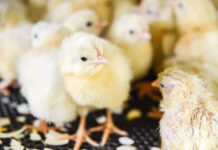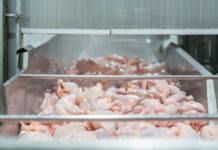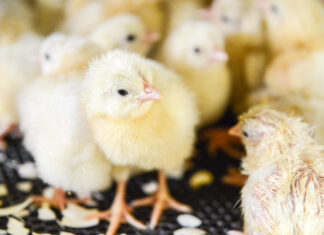
Kenya’s broiler chicken population declined by more than 8% in 2024 due to the high cost of feed and an increasing preference for indigenous chicken meat, according to one of the latest official government reports.
The report by the Kenya National Bureau of Statistics (KNBS) says the country’s broiler chicken population dropped to 5 million birds from 5.5 million the previous year. A similar decline was reported in 2023 when the population declined to 5.5 million down from 5.59 million in 2022.
The falling broiler numbers in Kenya for 2024 were consistent with increasing poultry feed prices that the Competition Authority of Kenya (CAK), a government agency that promotes and protects effective competition in markets, attributes to the high cost of raw materials.
For instance, the CAK says in one of its 2024 reports: “Despite inputs to animal feed being abundantly available in the region, feed prices have been extremely high, making producers of poultry, dairy, and other livestock uncompetitive”.
CAK says the main cause of the high feed prices is the prices of important inputs, such as soybean and maize, a trend that has triggered high prices for products such as eggs and poultry.
The Authority lists Kenya among countries where feed prices are relatively high compared to available international benchmark prices says “The feed prices have been much higher than would be expected in well-functioning markets with effective competition”.
“Feed prices increased substantially over 2021 and 2022, consistent with high poultry prices in Kenya for consumers” CAK adds.
Previously, Kenya’s growing trend of embracing dual-purpose chicken breeds, especially in rural areas, in the last 10 years could be one of the reasons the commercial broiler numbers in this country of 56 million people has been on the decline.
Meanwhile, in its September 2025 report, KNBS said the populations of layer and indigenous chicken increased by 7.4% and 9.2%, respectively compared to 2023 due “to increased demand for eggs, while the increase in indigenous chicken population was due to widespread commercialization promotion by many county governments, and consumer preference for indigenous-based diets due to its perceived higher nutritional value and health benefits compared to exotic chicken”. Kenya’s poultry consumption per capita is estimated at 2.5 kilogrammes per year up from 1.70 kg in 2021.
Indigenous chicken, which constitutes 75% of Kenya’s poultry population and provides the much-needed high-value protein and income for rural households, has recorded a steady growth five years in a row, from an estimated 47.4 million in 2020 to 59.3 million at the end of 2024, according to the KNBS statistics. The report lists five of the country’s 47 counties, Kitui, Migori, Homabay, Kisumu and Bungoma as leading producers of indigenous chicken in Kenya in 2024.
This increasing preference for indigenous poultry breeds persists despite market research indicating that meat and eggs from these breeds face major challenges, such as limited access to larger markets due to inadequate cold storage facilities, poor transportation infrastructure, and restricted entry into retail chains. As a result, producers are often confined to local or informal markets, where prices are low and profits minimal, according to the Kenya Institute for Public Policy Research and Analysis (KIPPRA), a state agency that provides policy advice to the government and other stakeholders.
Elsewhere, the KNBS report shows the surge in Kenya’s poultry meat production reported in 2020, continued unabated to the end of 2024 when the country’s output hit 102.5 million kilogrammes, a 40% increase from the 69.2 million kilogrammes produced five years ago.
Although the value of the poultry meat produced in Kenya fluctuated dramatically over the five years to 2024, it was at its highest last year at KES 68.6 billion (EUR 453.3 million), nearly 101% compared to the KES 34 billion (EUR 224.7 million) five years ago.
Moreover, the KES 68.6 billion (EUR 453.3 million) value for 2024, was also 97% more than the KES 34.7 billion (EUR 229.3 million) for 2023.
Despite this increase in poultry meat production by Kenya, the country’s Chamber of Commerce says major consumers such as the American chain of fast food restaurants, KFC, “continue to source chicken meat from South Africa due to limited local supply and processing standards.”
“In addition, the limited number of certified abattoirs and processing facilities restricts the country’s export potential — especially to high-demand markets in the Middle East, where strict sanitary and quality standards apply,” the Chamber adds.
KNBS says in 2024, Kenya’s egg output was estimated at 221.7 million trays worth approximately KES 103.1 billion (EUR 681.2 million). This was an increase of 13.9% in quantity and 14.3% in value respectively from the previous year. Despite this increase, the Kenya Chamber of Commerce and Industry estimates Kenya’s annual egg imports at 5 billion eggs.
Meru County in central Kenya topped the list of the top 10 egg-producing counties in 2024 with 69.2 million trays of eggs during the year ahead of Tana River and Uasin Gishu counties with an estimated 32.3 million trays and 23.9 million trays respectively.
Other previous reports indicate Kenya imported an estimated 412 metric tons valued at USD 1.5 million (EUR 1.3 million) of hatching eggs primarily from Tanzania, Zambia, Turkey, and the Netherlands, probably a confirmation of concerns the Kenyan egg market still grapples with widening supply deficit of the poultry product.
















